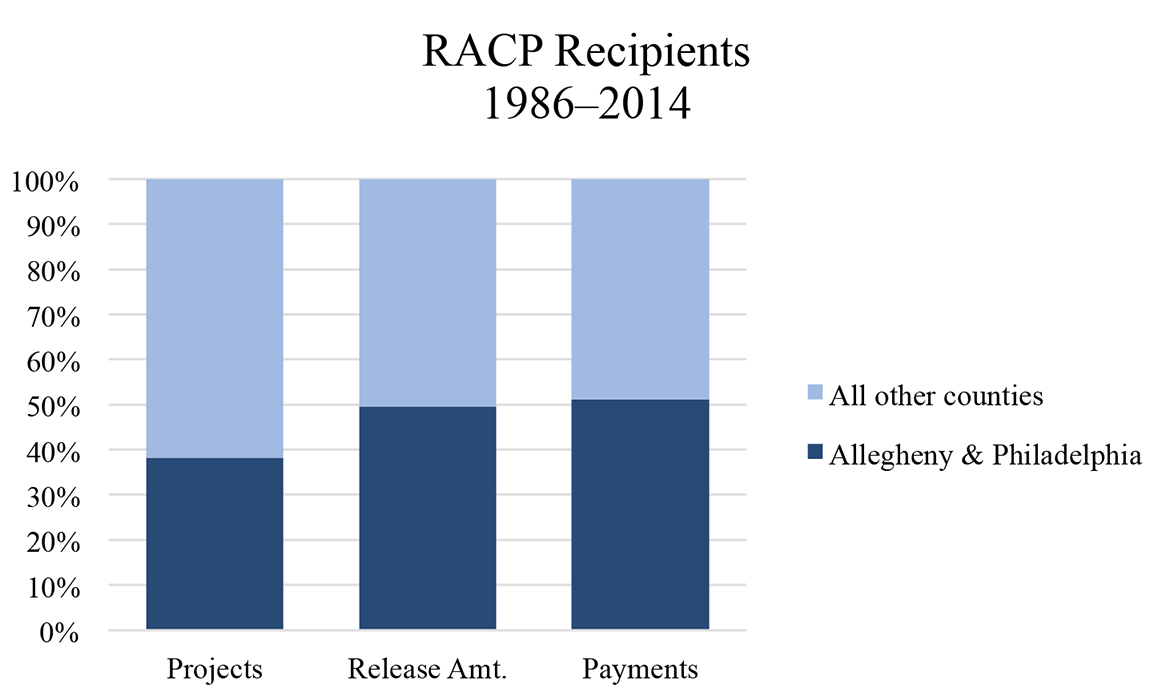- | Academic & Student Programs Academic & Student Programs
- | Housing Housing
- | Research Papers Research Papers
- |
Does Pennsylvania’s Redevelopment Assistance Capital Program Develop Its Economy?
A new study for the Mercatus Center at George Mason University examines the RACP and finds that while the grant program does generate some employment at the county level, the gross effect is small and the net effect is actually closer to zero because money distributed to some counties is transferred from other Pennsylvania counties, either through fewer grants or higher taxes that fund the bonds.
Several states administer targeted grant programs that provide funding to businesses that relocate to the state or expand existing operations within the state. Pennsylvania’s version is called the Redevelopment Assistance Capital Program (RACP). At its creation in 1986, the program had borrowing authority of $400 million. In 2010, its borrowing authority reached over $4 billion. Supporters contend that these grants to private businesses, which are funded through taxpayer- supported government bonds, create jobs and encourage innovation.
A new study for the Mercatus Center at George Mason University examines the RACP and finds that while the grant program does generate some employment at the county level, the gross effect is small and the net effect is actually closer to zero because money distributed to some counties is transferred from other Pennsylvania counties, either through fewer grants or higher taxes that fund the bonds. Additionally, the RACP is likely to decrease economic growth in the long run since the market is ultimately skewed away from efficient investments and toward politically favored industries. Rather than pick winners and losers, government should refrain from interfering in the market through government business grants.
To read the study in its entirety and learn more about its author, research fellow Adam Millsap, see “Does Pennsylvania’s Redevelopment Assistance Capital Program Develop its Economy?”
KEY HIGHLIGHTS
The study conducts an empirical analysis of the RACP, looking at the program’s largest award year (2010) and subsequent years. The program generates a small amount of gross employment in the recipient counties, while economic theory and additional evidence suggest that the program generates negligible net employment for the Commonwealth of Pennsylvania. The RACP is an inefficient and market-distorting program that mostly transfers economic activity from counties receiving less in RACP grants to counties receiving more of the grants:
- Two major counties receive disproportionate benefits relative to the rest of the state. The study finds that a large amount of the RACP funds—approximately 50 percent—have been awarded to businesses in the two counties of Allegheny and Philadelphia. These counties also happen to include the two largest cities in the state, Pittsburgh and Philadelphia, but only contain around a quarter of the state’s population. Funds are disproportionately distributed to these two counties.

- There are unseen effects of government grants to businesses. It is easy to see the jobs that are created by the companies that receive RACP grants, but harder to see the lost economic activity due to the taxation that funds the grants. This unseen effect is often ignored in other studies on job development programs, but it has a real impact on communities and taxpayers.
- Minimal job creation. The RACP does generate some employment at the county level, but the gross effect of that job creation is small. The net effect of the grant program’s impact on job creation is closer to zero, because increasing the funding in one county will often mean taking from another county, resulting in job losses in the latter county.
CONCLUSION
Business grant programs and other programs designed to generate jobs often ignore the unseen effects of reallocating resources from one place to another. While some businesses and localities receive funds that generate some new employment, other areas within the state will have less economic activity in their area as a result. These smaller decreases in economic activity are harder to see and measure, but they inhibit economic growth, harming real people and real communities.
To speak with a scholar or learn more on this topic, visit our contact page.

